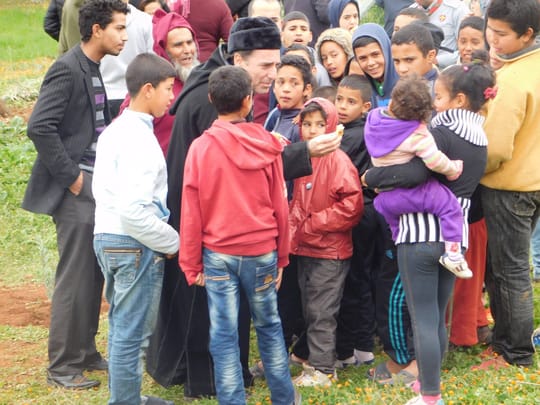By Lillian Thomson
January 2016
Since the first group of Peace Corps Volunteers (PCVs) arrived in Morocco in 1963, over 5,000 Americans have served in the Peace Corps’ partnership with Morocco to develop resilient communities through education and similar voluntary initiatives. In 2010 I was sent to work with Yossef Ben-Meir, president of the High Atlas Foundation (HAF), which turns fifteen years old this year. Yossef was an environmental PCV in 1993-1995. His story, and the story of the High Atlas Foundation, which was founded by Returned Peace Corps Volunteers (RPCVs) who served in Morocco, is a testimonial to the lasting impact Peace Corps service can have.
Yossef’s kitchen was a Moroccan version of Whole Foods, so over chicken tajine, I asked him how it all came about. It’s a story of PCVs’ love of Morocco, of each other, and a lifetime commitment to Peace Corps’ “three goals.”
As a Volunteer from New York City, Yossef was assigned to a remote mountain village where he worked for the national park system and learned how to succeed in agriculture in an environment where water contributes more to erosion than crops. A highly motivated entrepreneur, Yossef knew he had to come back and continue his new-found calling in arid mountain agriculture. When he arrived at the airport, RPCV Tom Anderson, who had finished grad school and come back to run the seaman’s club in Casablanca, picked him up at the airport. Tom urged Yossef to apply for the environmental program manager’s job at Peace Corps-Morocco, which he did.
The friends’ decision to form a nonprofit, instead of a business, set the course for the High Atlas Foundation. It would become an organization that has brought RPCVs, PCVs and Moroccans together. Fundraising events in New York brought Moroccan culture to America and helped attract a strong American-Moroccan board. Liz Fanning, who had been Yossef’s site mate and fellow environmental Volunteer, served as vice president for six years. Kate McLetchie, who had been evacuated from Morocco in 2003, reconnected, and later became the foundation’s first country director from 2007 to 2009.
In 2003, Yossef and Mohssine Tadlaoui, a Moroccan who had taken over as Peace Corps’ environmental program manager, went to see the U.S. Ambassador to Morocco, Margaret Tutwiler, who had a reputation for toughness. Yossef and Mohssine were on a mission to plant fruit trees to produce cash crops and help prevent erosion high in the mountains. Several agriculture experts were present, including the head of USAID.
Yossef knew that planting trees was a grassroots business—not in the same league with the large-scale projects USAID was doing—but Yossef had his technical and business model down and was prepared to give it his best shot. In closing, he described the reaction of a mountain community when the first truck of saplings arrived in their village—“they cried,” Yossef said, “because they saw planting a tree as an act of faith.” “Well then,” replied the ambassador, “let’s spread some faith around.” The project was funded within a week and, in 2006, the HAF launched its One Million Tree campaign, which reached it goal in 2014.
These days, the High Atlas Foundation raises half of its funds in the U.S. and half in Morocco, with the assistance of the Moroccan and American ambassadors, and countless others who believe in the cross-cultural partnership.You will find them at “Heflas” (parties), drinking mint tea and enjoying the food, music and art of Morocco, including Moroccan films at festivals the HAF organized in New York in 2010 and 2011.
Besides planting trees, the High Atlas Foundation has constructed irrigation canals, drinking water supply systems, women’s co-ops, and numerous other projects identified through participatory development meetings in communities. In 2009, the foundation formed a partnership with the state university, Hassan II, to open a Center for Community Consensus-Building and Sustainable Development in Mohammedia. During my service, I helped create a program at the Center to educate and promote participatory development. Since that time, the HAF has created four new university partnerships.
In retrospect, I believe that I went to Morocco to meet Yossef and the Moroccans and Americans who continue this legacy of Peace Corps service.
Lillian Thompson
Peace Corps Response Volunteer, Morocco 2010
Peace Corps Volunteer, Ukraine 2003-2005
Peace Corps Program & Training Officer, Romania 2006-2008
Source of data in first paragraph: https://morocco.usembassy.gov/peacecorps.html
Photos: 1) Villagers hauling water in a community outside Mohammedia in 2010 2) Mountain village in the High Atlas Mountains near Marrakech 3) Lilian with Yossef and HAF members Suzanne, Miriam and Nabila in Casablanca 4) Nabila facilitating a meeting of women in the High Atlas Mountain village
